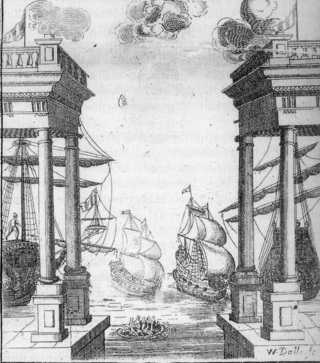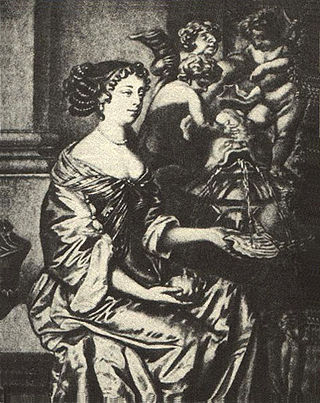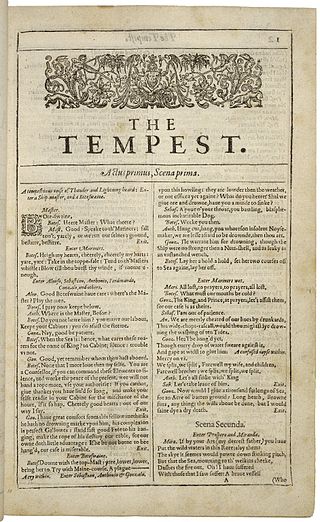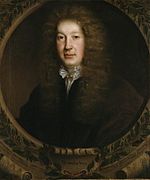Related Research Articles

John Dryden was an English poet, literary critic, translator, and playwright who in 1668 was appointed England's first Poet Laureate.

Sir William Davenant, also spelled D'Avenant, was an English poet and playwright. Along with Thomas Killigrew, Davenant was one of the rare figures in English Renaissance theatre whose career spanned both the Caroline and Restoration eras and who was active both before and after the English Civil War and during the Interregnum.
Tempest is a synonym for a storm.
This article contains information about the literary events and publications of 1674.
This article contains information about the literary events and publications of 1667.
Nahum Tate was an Anglo-Irish poet, hymnist and lyricist, who became Poet Laureate in 1692. Tate is best known for The History of King Lear, his 1681 adaptation of Shakespeare's King Lear, and for his libretto for Henry Purcell's opera, Dido and Aeneas.

The Comedy of Errors is one of William Shakespeare's early plays. It is his shortest and one of his most farcical comedies, with a major part of the humour coming from slapstick and mistaken identity, in addition to puns and word play. It has been adapted for opera, stage, screen and musical theatre numerous times worldwide. In the centuries following its premiere, the play's title has entered the popular English lexicon as an idiom for "an event or series of events made ridiculous by the number of errors that were made throughout".

The Restoration spectacular was a type of theatre production of the late 17th-century Restoration period, defined by the amount of money, time, sets, and performers it required to be produced. Productions attracted audiences with elaborate action, acrobatics, dance, costume, scenery, illusionistic painting, trapdoors, and fireworks. Although they were popular with contemporary audiences, spectaculars have earned a reputation from theatre historians as vulgar in contrast to the witty Restoration drama.

King Arthur, or The British Worthy, is a semi-opera in five acts with music by Henry Purcell and a libretto by John Dryden. It was first performed at the Queen's Theatre, Dorset Garden, London, in late May or early June 1691.
The terms "semi-opera", "dramatic[k] opera" and "English opera" were all applied to Restoration entertainments that combined spoken plays with masque-like episodes employing singing and dancing characters. They usually included machines in the manner of the restoration spectacular. The first examples were the Shakespeare adaptations produced by Thomas Betterton with music by Matthew Locke. After Locke's death, a second flowering produced the semi-operas of Henry Purcell, notably King Arthur and The Fairy-Queen. Semi-opera received a deathblow when the Lord Chamberlain separately licensed plays without music and the new Italian opera.

Mary Saunderson (1637–1712), later known as Mary Saunderson Betterton after her marriage to Thomas Betterton, was an actress and singer in England during the 1660s and 1690s. She is considered one of the first English actresses.

The Duke's Company was a theatre company chartered by King Charles II at the start of the Restoration era, 1660. Sir William Davenant was manager of the company under the patronage of Prince James, Duke of York. During that period, theatres began to flourish again after they had been closed from the restrictions throughout the English Civil War and the Interregnum. The Duke's Company existed from 1660 to 1682, when it merged with the King's Company to form the United Company.
The Law Against Lovers was a dramatic adaptation of Shakespeare, arranged by Sir William Davenant and staged by the Duke's Company in 1662. It was the first of the many Shakespearean adaptations staged during the Restoration era.
Thomas Duffet, or Duffett, was an Irish playwright and songwriter active in England in the 1670s. He is remembered for his popular songs and his burlesques of the serious plays of John Dryden, Thomas Shadwell, Elkanah Settle and Sir William Davenant.

The Mock Tempest, or the Enchanted Castle is a Restoration era stage play, a parody by Thomas Duffet; it premiered in 1674, and was first printed in 1675 by the bookseller William Cademan. In creating his farce, Duffet's target was not Shakespeare's famous play, but the adaptation of it that John Dryden and Sir William Davenant wrote in the 1660s. According to critic Michael West, "There are frequent nautical metaphors, and 'more noyse and terrour than a Tempest at Sea'...."
Psyche is a semi-opera in five acts with music by Matthew Locke to a libretto by Thomas Shadwell with dances by Giovanni Battista Draghi. It was first performed at Dorset Garden Theatre, London on 27 February 1675 by the Duke's Company with choreography the French dancing-master Saint-André. Stage machinery was by Thomas Betterton and the scenery by Stephenson. The work is loosely based on Molière's 1671 tragédie-balletPsyché with incidental music by Lully.

The Tempest is a play by William Shakespeare, probably written in 1610–1611, and thought to be one of the last plays that he wrote alone. After the first scene, which takes place on a ship at sea during a tempest, the rest of the story is set on a remote island, where Prospero, a complex and contradictory character, lives with his daughter Miranda, and his two servants: Caliban, a savage monster figure, and Ariel, an airy spirit. The play contains music and songs that evoke the spirit of enchantment on the island. It explores many themes, including magic, betrayal, revenge, and family. In Act IV, a wedding masque serves as a play-within-a-play, and contributes spectacle, allegory, and elevated language.

Cave Underhill (1634–1710?) was an English actor in comedy roles.
The History of Timon of Athens the Man-hater by Thomas Shadwell is a 1678 adaptation of Timon of Athens, the play by William Shakespeare.
Die Geisterinsel is an opera libretto written by German poet and dramatist Friedrich Wilhelm Gotter (1746–1797), based on an earlier version by his friend Friedrich von Einsiedel. The libretto is based on Thomas Shadwell's operatic adaptation of Dryden's The Enchanted Island, which in turn is inspired by Shakespeare's The Tempest. Following Gotter's death, his widow was persuaded by Schiller to publish the late husband's libretto in his Die Horen, appearing in issues 8 and 9 of 1797.
References
- ↑ Guffey, George R, ed. (1969). After The tempest. Los Angeles: William Andrews Clark Memorial Library, Univ. of California. OCLC 310876195.
- ↑
 Laurie, Margaret (1963), "Did Purcell Set 'The Tempest?'", Proceedings of the Royal Musical Association, 90: 43–57, doi:10.1093/jrma/90.1.43, JSTOR 766005, OCLC 5548452243
Laurie, Margaret (1963), "Did Purcell Set 'The Tempest?'", Proceedings of the Royal Musical Association, 90: 43–57, doi:10.1093/jrma/90.1.43, JSTOR 766005, OCLC 5548452243 - ↑ Duffett, Thomas (1972). DiLorenzo, Ronald Eugene (ed.). Three burlesque plays of Thomas Duffett : The Empress of Morocco, the mock-tempest, Psyche debauch'd . Iowa City: University of Iowa Press. ISBN 9780877450337. OCLC 589050.

